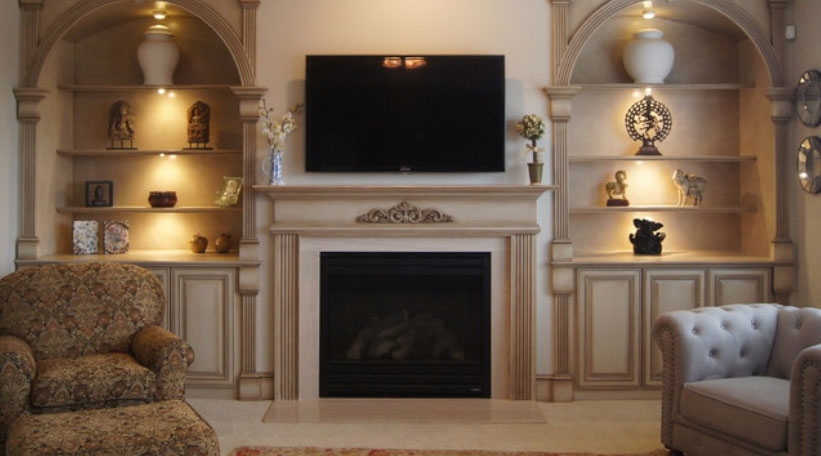Faux finishes are popping up in all sorts of home spaces.
By Tammy Adamson-McMullen
You may have done it on a feature wall or on a small piece of furniture, but don’t stop there. There are so many other places where you can create a faux finish!
Faux finishing is as popular as ever because it brings color, texture and flair to a space and helps to create a truly customized look. Whether you choose to create a faux finish on your own or hire a professional decorative artist, there are many finishes that are trending at present and many places to apply them. Here are some ideas to get your faux juices flowing.
Ceilings
The ceiling currently is one of the most popular places to apply a faux finish. Ceiling finishes fulfill a number of different functions. They help to define the spaces where they’re applied; add color, texture and drama; and make an area appear larger by drawing the eye upward.
At present, trending finishes on the “fifth wall” tend to have some shine. They include pearlescent and metallic glazes, polished Venetian plasters and ceiling medallions with a bit of gilding or gold-leafing. Painted ceiling medallions in particular can get very elaborate, with stenciled or free-hand designs incorporated into the metallic finish. These types of reflective finishes are especially prevalent in high-end construction but also are finding their way into mid-range homes. You’ll see them in entryways, dining rooms, studies, master bedrooms and even chic bathrooms.
More intricate finishes, such as trompe l’oeil (a technique that makes the finish appear three- dimensional) and colorful murals (a la Michelangelo), also are gaining overhead. But even a simple glazing or color-washing—in a color of your choosing—can add a lot of flair to a space.
Fireplaces
Fireplace mantels, hearths, trim pieces and surrounds are other fantastic areas for faux finishes. Finishes that mimic marble, granite and other stones are well-suited for these areas and, of course, are less expensive than the real thing! And unlike real stone, faux finishes can be easily changed as your decorating tastes and styles change. Reflective finishes are trending here, too. So don’t be afraid to add a bit of gold and silver veining to your marblezing, or metallic sprinkles to your “granite.”
Bas reliefs also work well in fireplace settings, especially if your style is classical and your fireplace is large enough to accommodate the look. Authentic bas reliefs are low-profile sculptures that appear to emerge from the stone or wood in which they are carved. As a faux finish, bas reliefs tend to be made from plaster and then are applied to a surface—in this case, usually the mantle or trim pillars. Possible motifs include cherub faces, fleur-di-les, family crests, garlands, flowers, leaves and pine cones, but the prospects are nearly endless.
Niches and Alcoves
Niches, alcoves and similar recesses nearly cry out for a faux finish! When these areas are straight-painted like the rest of the room, they recede into the background; but when highlighted with a faux finish, they become the stars they were meant to be.
Metallic and pearlescent finishes are by far the most prevalent here. They not only lend a look of elegance but also help to showcase any artwork that might be housed within the space. Plaster and tissue effects that give the impression of aged stucco also work well in recessed spaces. Once the plaster or tissue has dried, you can either straight-paint the effect or apply another faux finish, such as glazing.
Stenciling is another good candidate for a niche or alcove. Be sure to choose a stencil pattern that works not only with the shape of the recess—geometric patterns are good options—but also with the rest of your décor. And don’t select anything that’s too “match-y.” If you have floral upholstery in the room, for instance, select a floral stencil in a larger or smaller pattern or opt for just a single stem.
Smaller Areas
Stairwells, reading nooks, wine cellars, play corners and other small spaces are ideal for all of the finishes already mentioned as well as one more: rag-rolling. No, this finish hasn’t gone away; in fact, it’s more popular than ever. The difference in 2019 is that the colors are more subtle, sophisticated and closer in hue (often found on the same paint chip, for example). Additionally, only two colors—a basecoat and topcoat—are ever used.
Imbedded plasters also work well in small spaces, especially those that have a specific purpose. The finish is created by inserting foreign objects—usually paper—into layers of plaster to create a look of antiquity, as if the objects are peeking out from a crumbling surface. To the walls of a reading nook, for example, pieces of newsprint might be imbedded in the plaster; in a wine cellar, wine reviews or bottle labels; in a child’s play corner, pages from a favorite book. Once the plaster has dried, a glaze or light varnish usually is applied on top in a translucent color.
Accessories
If you’ve never faux-finished before but love the look a faux finish provides, start with something smaller, like a vase, lamp, picture frame or flower pot. Glazes, marbleizing, color washes and stenciling are ideal techniques for accessories, as are crackled finishes and decoupages. Faux-finished accessories allow you to further customize your space and to show off your skills. Just be sure to protect your final creation with a clear sealer or coat of varnish.

 Interior Paints
Interior Paints Exterior Paints
Exterior Paints Primers
Primers Stains & Clears
Stains & Clears
 Paint Brushes
Paint Brushes Paint Roller
Paint Roller Paint Trays & Liners
Paint Trays & Liners
